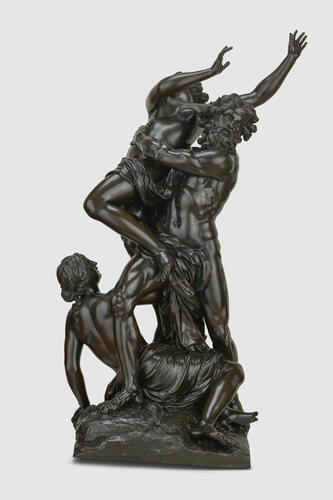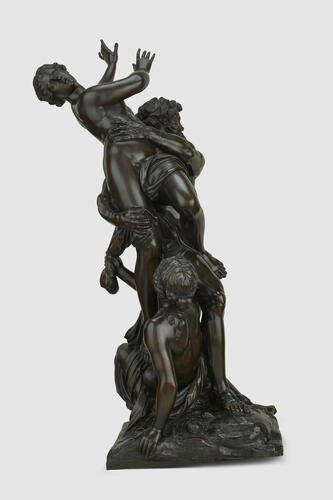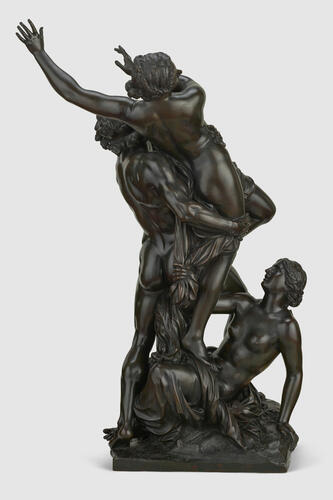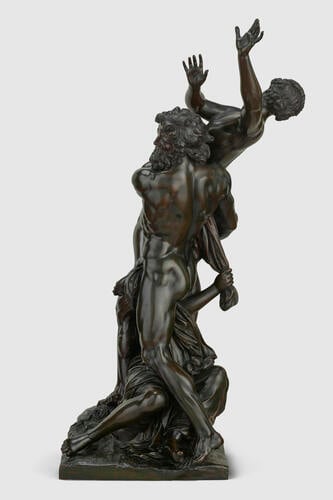-
1 of 253523 objects
The abduction of Proserpine by Pluto 1st dec 18th cent.
Bronze | 97.4 x 54.5 x 56.0 cm (whole object) | RCIN 44191




-
François Girardon was the pre-eminent sculptor of the reign of Louis XIV. His best-known works are the colossal bronze equestrian statue of the King, cast in 1692 for the Place Louis-le-Grand (Place Vendôme) in Paris, and those which formed part of the Grande Commande of 1674 for twenty-four statues to ornament the gardens of Versailles. His marble statue of The Abduction of Proserpina was one of four groups of similar subjects intended to represent the four elements at the four corners of the Parterre d'Eau. (The others were of Boreas and Orytheia - Air - by Marsy, Saturn and Cybele - Fire - by Regnaudin, and Neptune and Coronis - Water - commissioned from Tuby.) The choice of subjects was an invitation to the French sculptors to surpass the famous two- and three-figure groups of Giambologna and Bernini. Girardon's group, which was completed in 1699, was the most direct challenge to Bernini, whose version of the same subject (of 1622, Rome, Villa Borghese) he no doubt knew at first hand, having twice visited Rome. Since they were to occupy corners of the parterre, the Versailles groups were designed to be seen chiefly from the front.
Girardon's marble was reproduced as a small bronze from the late seventeenth century onwards. Many examples, measuring approximately 53 centimetres high - often paired with either Marsy's Boreas and Orytheia or Giambologna's Rape of a Sabine, and mounted on ormolu bases - were made during the eighteenth century as bronzes d'ameublement for fashionable apartments; the Royal Collection also includes one such small bronze. The present bronze is one of only six known casts of a larger size, two of which were in the possession of the sculptor at the time of his death in 1715, and which probably derive from his small model for the marble group. Some of these larger bronzes, including the signed and dated version at Strasbourg (Château des Rohan) and another now at Versailles were cast in 1693. The signed bronze in the J. Paul Getty Museum (Los Angeles) which, like the Versailles marble, has a circular base, is probably the finest of the known casts in this size. Only the present cast and another (Dresden, Staatliche Kunstsammlungen), which was purchased for Augustus the Strong, Elector of Saxony, in Paris in 1715, have square bases, which was apparently the form of those that belonged to the sculptor.
The subject is taken from Book V of Ovid's Metamorphoses. Pluto, having risen from his underground realm to inspect the damage caused by an earthquake in Sicily, is struck by Cupid's dart and compelled to carry the nymph Proserpina (Persephone) back to the underworld. The third figure is probably Cyane, another nymph who attempted to resist Pluto; she found herself transformed into a river, dissolved by her own tears.
George IV acquired a number of bronze statuettes of this subject. This is probably the 'large Bronze Group, the Rape of Proserpine mounted on an Ormolu Stand' which arrived at Carlton House in May 1811.
Catalogue entry from Royal Treasures, A Golden Jubilee Celebration, London 2002Provenance
Probably the bronze purchased by the Prince Regent from Phillips in May 1811.
-
Creator(s)
Acquirer(s)
-
Medium and techniques
Bronze
Measurements
97.4 x 54.5 x 56.0 cm (whole object)